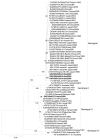Introduction of Japanese encephalitis virus genotype I, India
- PMID: 21291622
- PMCID: PMC3204761
- DOI: 10.3201/eid1702.100815
Introduction of Japanese encephalitis virus genotype I, India
Figures

References
-
- Saxena SK, Mishra N, Saxena R, Singh M, Mathur A. Trend of Japanese encephalitis in north India: evidence from thirty-eight acute encephalitis cases and appraisal of niceties. [PMID: 19762970]. J Infect Dev Ctries. 2009;30:517–30. - PubMed
Publication types
MeSH terms
Substances
LinkOut - more resources
Full Text Sources
Molecular Biology Databases
